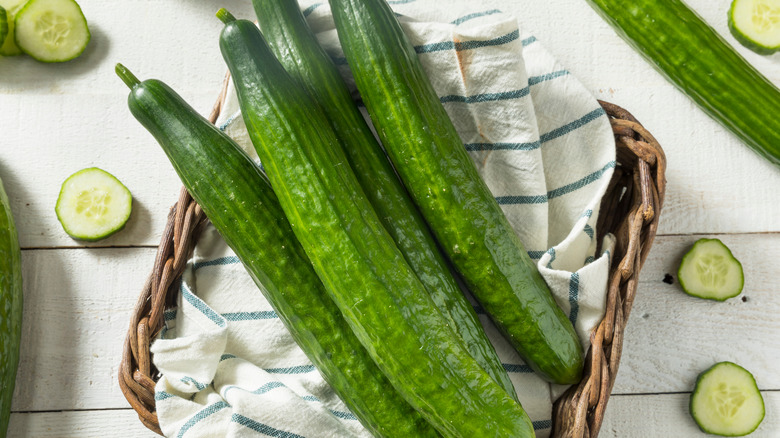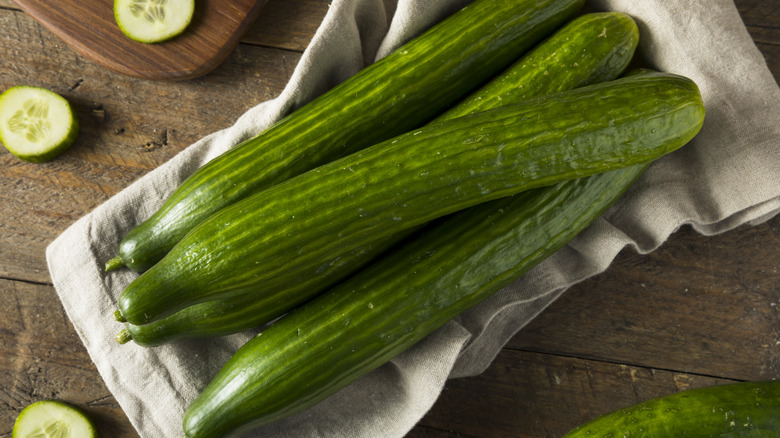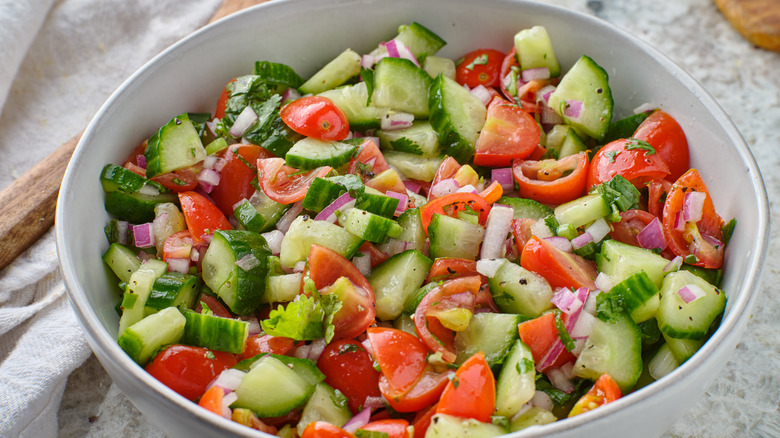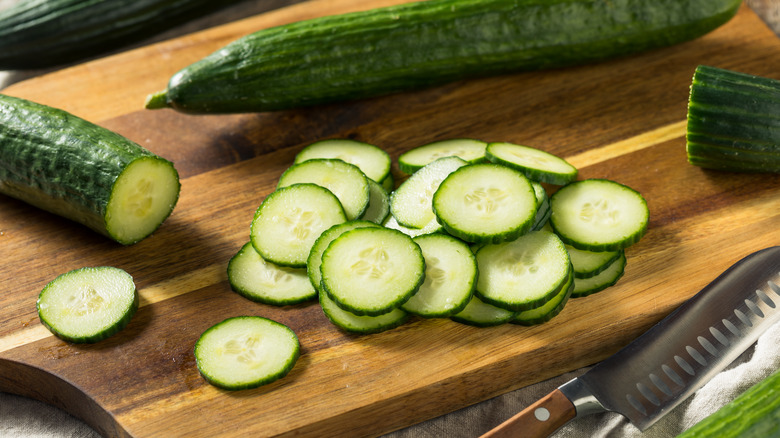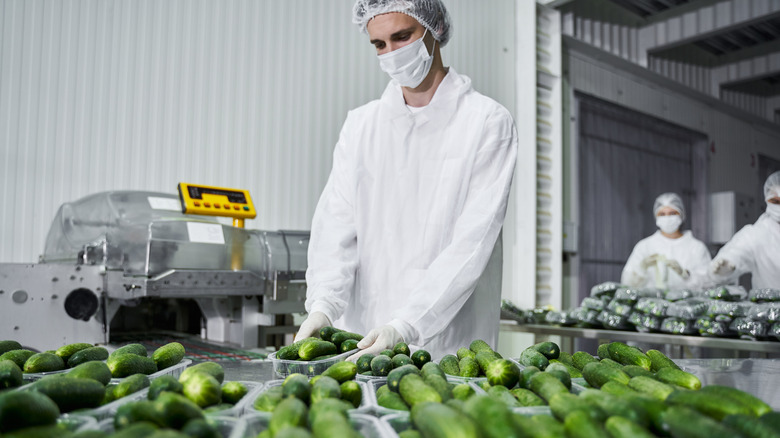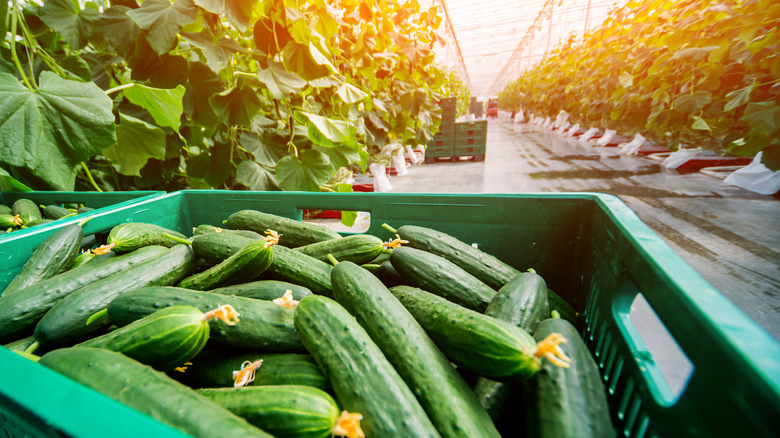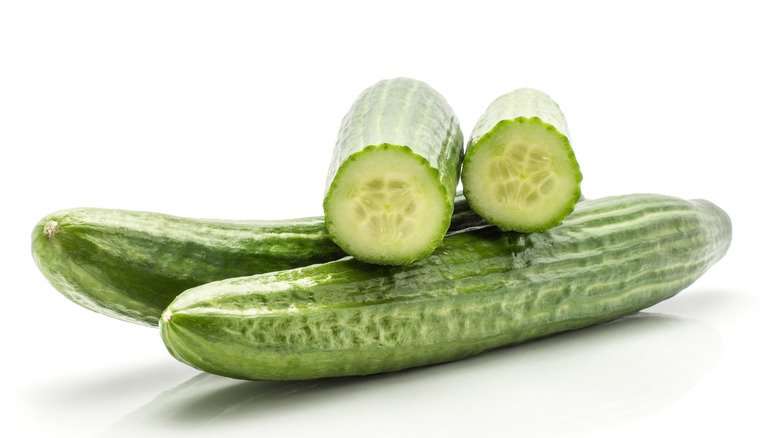What Are English Cucumbers And Why Are They Sometimes Wrapped In Plastic?
Cucumbers are easily one of the crispest, most refreshing flavors among all fruits and vegetables. It is one of the rare vegetables that is more often enjoyed raw than it is cooked, but it is a cherished ingredient across many cultures, a star in everything from tzatziki and Israeli salads to Greek salads and good ol' pickles, in their many sizes and flavors.
Shopping for cucumbers, though, can get a bit tricky. It's not at all unusual for a supermarket's produce aisle to feature a mind-boggling array of cucumbers — so many different types, sizes, and slight flavor variations. Of course, which variety you purchase depends on you're planning to use it for, but one of the more beguiling questions about shopping for cucumbers is why the heck certain cukes are plastic-wrapped? What is the purpose? Is it environmentally sustainable? Does it affect the flavor of the cuke? Don't fret; we're here to answer these burning questions for you.
What is an English cucumber?
As far as differences in cucumbers, you may have heard of English (also called European or hothouse), gherkin, kirby, and Persians, but did you know that there are actually 100 varieties worldwide, according to The Spruce Eats? They originated in South Asia and are a part of the gourd family. Many also divide cucumbers with two simpler distinctions: slicing vs. pickling. The English/hothouse cucumber is actually a third category altogether. This cucumber is virtually seedless, with a sweeter, milder taste. Because the seeds are ostensibly undetectable, there is no need to remove them prior to eating.
Pickling and slicing cucumbers, on the other hand, tend to have larger seeds, thicker skin that can tend to taste slightly bitter, and they're usually much more stout than the elongated English cuke. Fine Cooking notes that an English cucumber tends to be between 10 and 12 inches, which is almost double the length of other non-hothouse cucumbers. They are available year-round, but are technically in season during the summer, according to Martha Stewart. They are also nutrient-rich, which is even more beneficial when eating them raw.
How do you cook with cucumbers?
As for using cucumbers, the options are nearly endless. They make both great dips and are an excellent gluten-free dipper; they're delicious in cold salads and alongside warm noodle or rice salads; and they pair beautifully with dairy, such as in raita or tzatziki (via The Kitchn). They also make those terrific little cucumber sandwiches for tea! They're great as crudité or in just about any kind of green salad. Their mild sweetness pairs well with lots of different herbs and vegetables, and they're often mild enough to help bolster a variety of proteins.
Of course, they're also great in smoothies, green juices, seltzers, flavored waters, and cocktails. Some people also cook them; a grilled cucumber is a fascinating interplay of flavors, and smashed, spiced cucumber dishes are wildly popular. Many also toss them in creamy dressings with bright, fresh herbs, or simply mix them with chopped tomatoes, oil, and vinegar. (Like we said: nearly endless options.)
Why are English cucumbers plastic-wrapped?
While the thinner skin can make for a more pleasant culinary experience, it's one of the many reasons for the plastic shrink wrap found on cucumbers in your local produce aisle. Martha Stewart notes that English cucumbers have more delicate skin than other cucumbers — hence the need to protect the skin from any potential stressors while in transit to and fro the grocery store.
The plastic also helps to preserve the cucumber. Life at the Table notes that English cucumbers lose exponentially less weight, and stay fresher far longer, when they're individually wrapped in plastic shrink wrap. The Spruce Eats relates that the skin can be "torn or nicked," which could shorten its shelf life or even result in mold, so the plastic wrap is a protective barrier while it also helps to ensure freshness. The Kitchn also notes that the plastic acts as an "insulator," which slows dehydration and spoilage.
How does the plastic wrap ensure freshness?
The plastic wrap is said to help a standard English cucumber last about 10 days. In addition, the individually wrapped vegetable also means that the cucumber literally goes untouched, unlike the majority of the other produce on display at the store. The Kitchn also notes the plastic plays an important role during packing, transit, in the store, and even once you get the cucumber home — the plastic helps the cuke stay fresh longer in your fridge, not just in the store. Cook's Illustrated notes that the plastic wrap creates an "airtight second skin," which keeps the cucumber fresh and reduces the chances of spoilage and condensation, which prevents moisture loss and helps freshness last much longer.
According to Independent, a longer-lasting cucumber means "less frequent deliveries," which in turn reduces the amount of waste, which also directly affects greenhouse gases. So indirectly and (perhaps a bit) ironically, that plastic wrap is helping the earth. At the same time, improperly disposed-of plastic can be dastardly for the environment.
How is the environment affected by the plastic wrap?
Ecoveritas tells us that it's important to balance the need to keep the food safe and edible, and therefore generally reduce food waste, against the environmental impact of plastic wrap. In recent years, countries such as the U.K. and Iceland have made concerted efforts not to sell plastic-wrapped produce for health and environmental purposes. Some ask, if stores have done away with plastic bags, why are we purchasing food directly wrapped in plastic? Of course, it all comes down to money — plastic is cheap, and the fresher the cucumber, the more produce sold, and that means more money for the supply chain.
The environmentally conscious are very concerned about the negative drawbacks of the plastic wrap; there are just under 25,000 signatures on a Change.org petition called "no more non-biodegradable plastic on cucumbers!" There are myriad discussions about other, more sustainable alternatives, which have also caught on in the U.S., especially with the company Apeel, which has made a concerted effort to assist in the plastic removal project by marketing what it calls a "plant-based" coating to protect produce, plastics-free.
The future of cucumbers
Pairing with Houwelling's to produce plastic-free cucumbers, Apeel notes that its product will protect cucumbers so that they will last longer without the need for potentially harmful plastic shrink wrap. Houwelling's is a "greenhouse grower and marketer dedicated to delivering a full complement of fresh tomatoes and cucumbers." As of late 2020, Apeel Long English Cucumbers were being sold in supermarkets and Walmarts in the western U.S.
Apeel employs a plant-based "peel" that is said to "slow water loss and oxidation that an lead to spoilage," hence no need for a plastic wrap. Apeel also states that this special cultivation also helps to keep the cucumbers purely emerald green. Fortune notes that the plant-based peel is almost in the vein of a banana leaf, resulting in a barrier that not only plastic-free, but edible. This peel helps keep moisture in and oxygen out, hence elongating the shelf life. "Every 500,000 cases of Apeel English cucumbers shipped will lead to the elimination of the equivalent of 820,000 single-use plastic after bottles and reduce green gas emissions by the equivalent of planting 790 trees," according to Fortune.
There is an inherent cool crispness to cucumbers — hence the famous maxim — and the ingredient is so versatile and nutrient-rich. We have high hopes that these new, environmentally sound alternatives will be long-lasting and signal a possible shift away from harmful plastics. We're excited to see what's to come!
